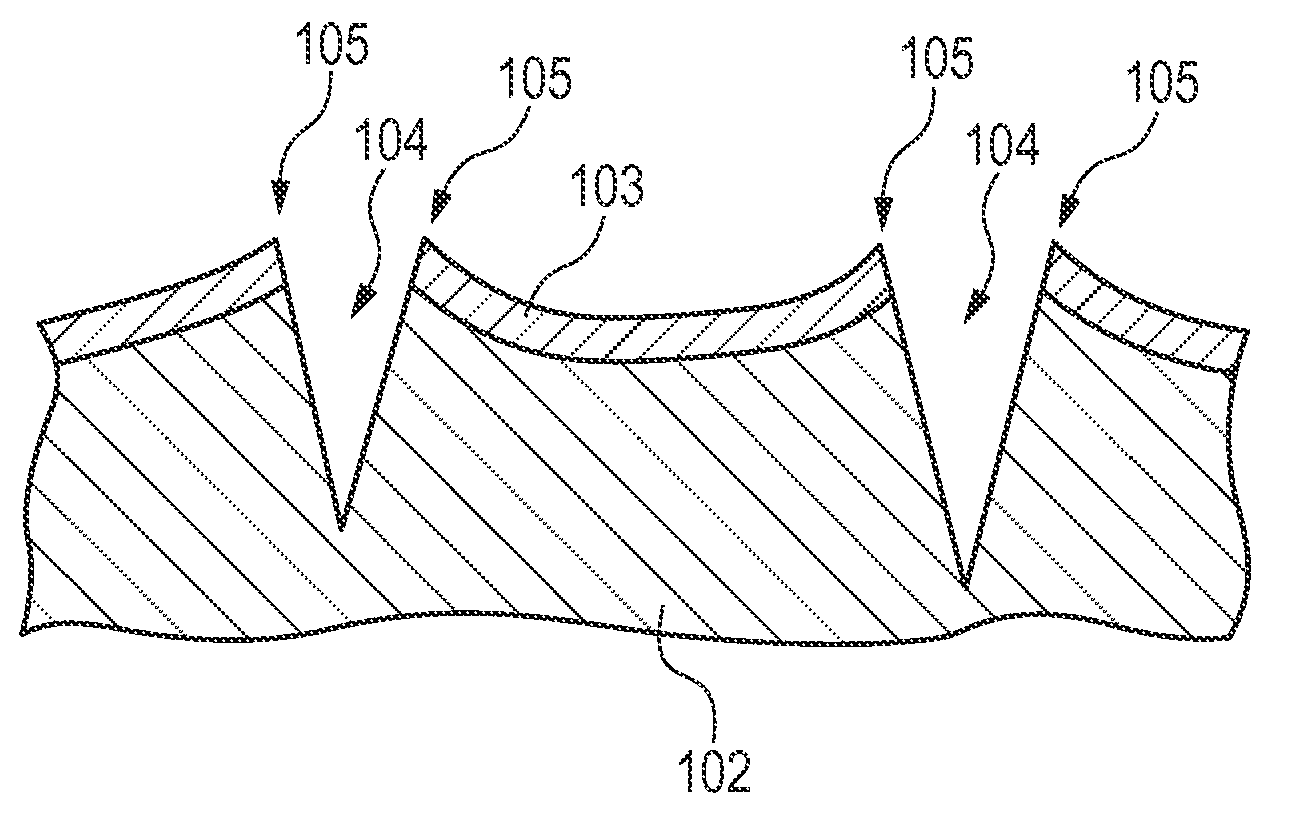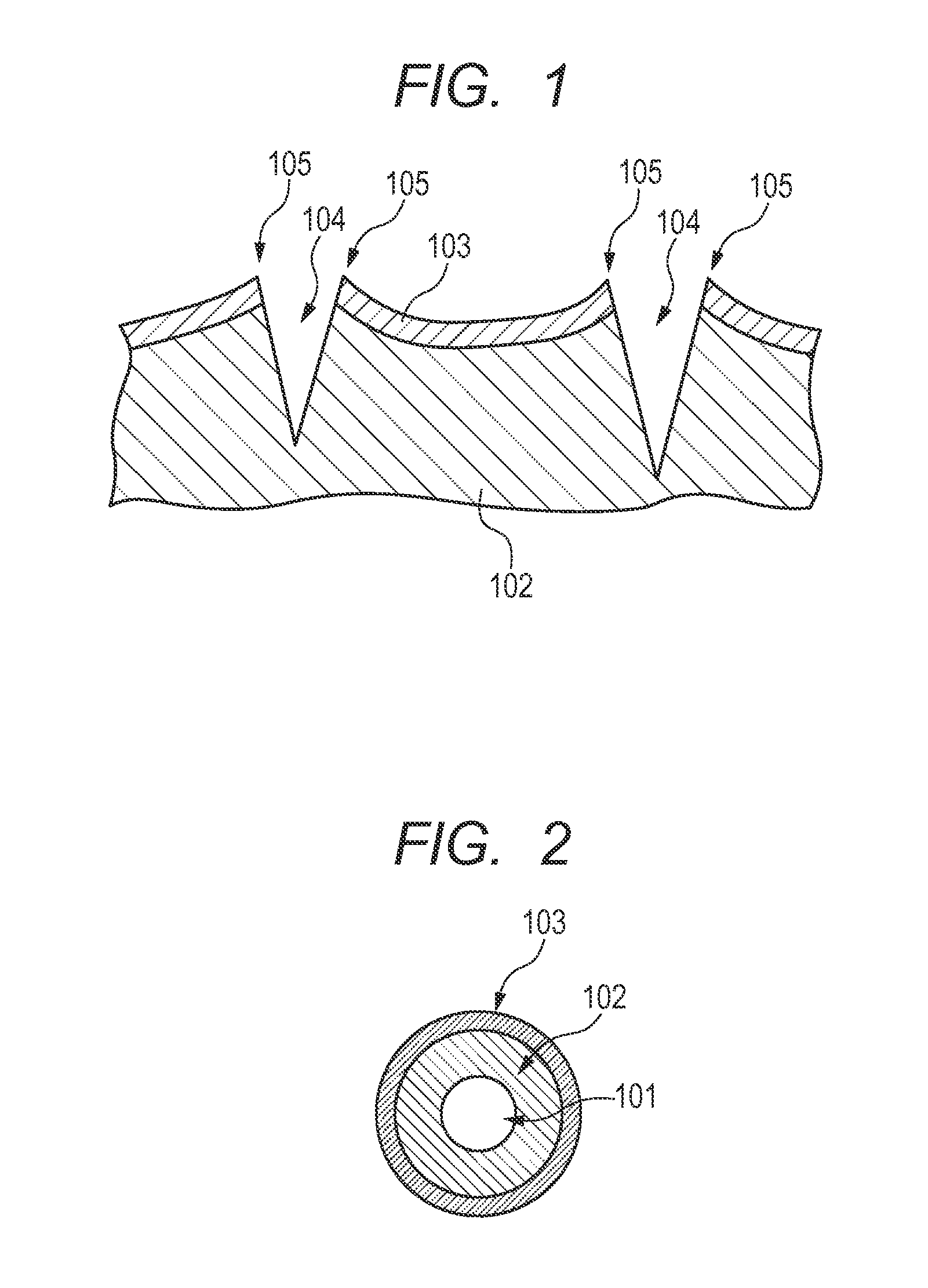Charging member and method for manufacturing the same
a charging member and charging technology, applied in the field of charging members, can solve the problems of difficult uniform roughening of difficult to form the surface layer with a rough surface, and difficult to uniformly roughen the surface of the surface layer, so as to reduce the thickness of the surface layer and improve the charging performance of the charging member
- Summary
- Abstract
- Description
- Claims
- Application Information
AI Technical Summary
Benefits of technology
Problems solved by technology
Method used
Image
Examples
example 1
Preparation of Charging Rollers 1-1 to 1-3
[0177]
[0178]To condensate 1, a solvent mixture of ethanol:2-butanol=1:1 (mass ratio) was added to adjust a solid substance concentration to 0.7%, 6.6% and 13.1%. These were designated as coating materials No. 1-1, 1-2 and 1-3.
[0179]
[0180]Three conductive elastic rollers 1 were prepared in the above [1]. To the outer peripheries of the conductive elastic layers of the conductive elastic rollers 1, coating materials No. 1-1 to 1-3 were applied, respectively, by ring coating (ejection amount: 0.120 ml / s, speed of a ring portion: 85 mm / s, total ejection amount: 0.130 ml). To the coating films of respective coating materials formed on the peripheral surfaces of the conductive elastic layers, UV ray having a wavelength of 254 nm was applied such that the cumulative light amount reached 9000 mJ / cm2. In this manner, condensate 1 of the coating material was crosslinked to form a surface layer. Note that irradiation of UV ray was performed by use of a...
examples 2 to 14
Preparation of Coating Materials 2-1 to 2-3, 3-1 to 3-3 for Forming a Surface Layer
[0197]Coating materials 2-1 to 2-3, 3-1 to 3-3 for forming a surface layer were prepared in the same manner as in coating materials 2-1 to 1-3 except that condensate 2 was used.
[0198]
[0199]To condensate 4, a solvent mixture of ethanol:2-butanol=1:1 (mass ratio) was added to control a solid substance concentration to be 0.3%, 6.6% and, 19.7%. These were designated as coating material Nos. 4-1, 4-2 and 4-3.
[0200]
[0201]To condensate 5, a solvent mixture of ethanol:2-butanol=1:1 (mass ratio) was added to control a solid substance concentration to be 0.3% and 19.7%. These were designated as coating material Nos. 5-1 and 5-2.
[0202]
[0203]To condensate 6, a solvent mixture of ethanol:2-butanol=1:1 (mass ratio) was added to control a solid substance concentration to be 0.3%, 6.6% and 19.7%. These were designated as coating material Nos. 6-1, 6-2 and 6-3.
[0204]
[0205]To each of condensates 7 to 14, a solvent mix...
example 15
Preparation of Coating Material 15 for Forming a Surface Layer
[0208]To condensate 15, a solvent mixture of ethanol:2-butanol=1:1 (mass ratio) was added to control a solid substance concentration to be 13.1%. This was designated as coating material No. 15.
[0209]
[0210]Charging rollers 15-1 to 15-6 were prepared in the same manner as in charging roller 1 except that coating material No. 15 was used and conductive rollers 2 to 7 were used in place of the conductive elastic roller 1, and subjected to evaluations (3) to (8).
PUM
| Property | Measurement | Unit |
|---|---|---|
| thickness | aaaaa | aaaaa |
| thickness | aaaaa | aaaaa |
| thickness | aaaaa | aaaaa |
Abstract
Description
Claims
Application Information
 Login to View More
Login to View More - R&D
- Intellectual Property
- Life Sciences
- Materials
- Tech Scout
- Unparalleled Data Quality
- Higher Quality Content
- 60% Fewer Hallucinations
Browse by: Latest US Patents, China's latest patents, Technical Efficacy Thesaurus, Application Domain, Technology Topic, Popular Technical Reports.
© 2025 PatSnap. All rights reserved.Legal|Privacy policy|Modern Slavery Act Transparency Statement|Sitemap|About US| Contact US: help@patsnap.com



